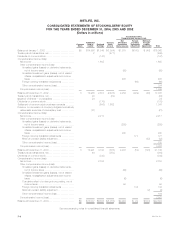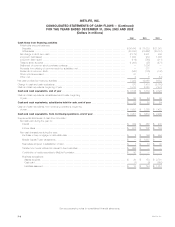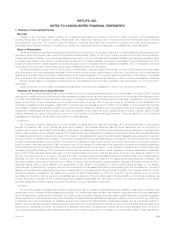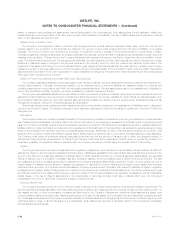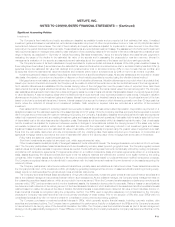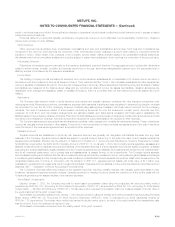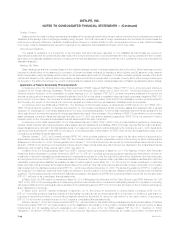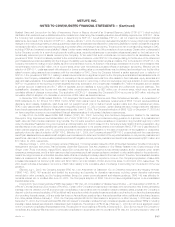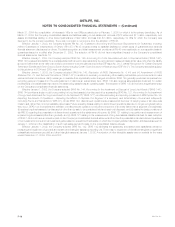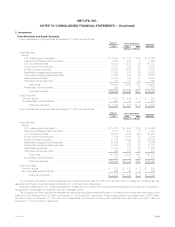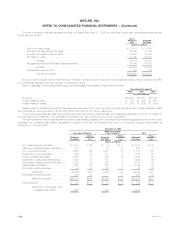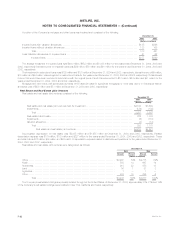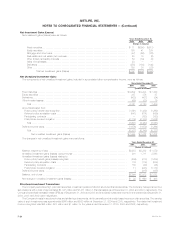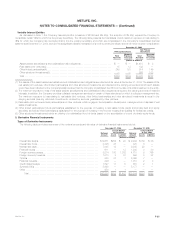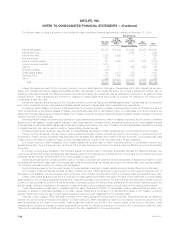MetLife 2004 Annual Report Download - page 59
Download and view the complete annual report
Please find page 59 of the 2004 MetLife annual report below. You can navigate through the pages in the report by either clicking on the pages listed below, or by using the keyword search tool below to find specific information within the annual report.METLIFE, INC.
NOTES TO CONSOLIDATED FINANCIAL STATEMENTS — (Continued)
Foreign Currency
Balance sheet accounts of foreign operations are translated at the exchange rates in effect at each year-end and income and expense accounts are
translated at the average rates of exchange prevailing during the year. The local currencies of foreign operations are the functional currencies unless the
local economy is highly inflationary. Translation adjustments are charged or credited directly to other comprehensive income or loss. Gains and losses
from foreign currency transactions are reported in earnings in the respective financial statement lines to which they relate.
Discontinued Operations
The results of operations of a component of the Company that either has been disposed of or is classified as held-for-sale are reported in
discontinued operations if the operations and cash flows of the component have been or will be eliminated from the ongoing operations of the Company
as a result of the disposal transaction and the Company will not have any significant continuing involvement in the operations of the component after the
disposal transaction.
Earnings Per Share
Basic earnings per share is computed based on the weighted average number of shares outstanding during the period. Diluted earnings per share
includes the dilutive effect of the assumed: (i) conversion of forward purchase contracts; (ii) exercise of stock options, and (iii) issuance under deferred
stock compensation using the treasury stock method. Under the treasury stock method, conversion of forward purchase contracts, exercise of the stock
options and issuance under deferred stock compensation is assumed with the proceeds used to purchase common stock at the average market price
for the period. The difference between the number of shares assumed issued and number of shares assumed purchased represents the dilutive shares.
Application of Recent Accounting Pronouncements
In December 2004, the Financial Accounting Standards Board (‘‘FASB’’) issued Staff Position Paper (‘‘FSP’’) 109-2, Accounting and Disclosure
Guidance for the Foreign Earnings Repatriation Provision within the American Jobs Creation Act of 2004 (‘‘AJCA’’). The AJCA introduced a one-time
dividend received deduction on the repatriation of certain earnings to a U.S. taxpayer. FSP 109-2 provides companies additional time beyond the
financial reporting period of enactment to evaluate the effects of the AJCA on their plans to repatriate foreign earnings for purposes of applying SFAS 109,
Accounting for Income Taxes. The Company is currently evaluating the repatriation provision of the AJCA. If the repatriation provision is implemented by
the Company, the impact on the Company’s income tax expense and deferred income tax assets and liabilities would be immaterial.
In December 2004, the FASB issued SFAS No. 153, Exchange of Nonmonetary Assets, an amendment of APB Opinion No. 29 (‘‘SFAS 153’’).
SFAS 153 amends prior guidance to eliminate the exception for nonmonetary exchanges of similar productive assets and replaces it with a general
exception for exchanges of nonmonetary assets that do not have commercial substance. A nonmonetary exchange has commercial substance if the
future cash flows of the entity are expected to change significantly as a result of the exchange. The provisions of SFAS 153 are effective for nonmonetary
asset exchanges occurring in fiscal periods beginning after June 15, 2005 and shall be applied prospectively. SFAS 153 is not expected to have a
material impact on the Company’s consolidated financial statements at the date of adoption.
In December 2004, FASB revised SFAS 123 to Share-Based Payment (‘‘SFAS 123(r)’’). SFAS 123(r) provides additional guidance on determining
whether certain financial instruments awarded in share-based payment transactions are liabilities. SFAS 123(r) also requires that the cost of all share-
based transactions be recorded in the financial statements. The revised pronouncement must be adopted by the Company by July 1, 2005. As all stock
options currently accounted for under APB 25 will vest prior to the effective date, implementation of SFAS 123(r) will not have a significant impact on the
Company’s consolidated financial statements.
Effective January 1, 2003, the Company adopted SFAS 148, which provides guidance on how to apply the fair value method of accounting for
share-based payments. As permitted under SFAS 148, the Company elected to use the prospective method of accounting for stock options granted
subsequent to December 31, 2002. Options granted prior to January 1, 2003 will continue to be accounted for under the intrinsic value method until the
adoption of SFAS 123(r), and the pro forma impact of accounting for these options at fair value will continue to be disclosed in the consolidated financial
statements until the last of those options vest in 2005. See Note 12.
In March 2004, the Emerging Issues Task Force (‘‘EITF’’) reached further consensus on Issue No. 03-1, The Meaning of Other-Than-Temporary
Impairment and Its Application to Certain Investments (‘‘EITF 03-1’’). EITF 03-1 provides accounting guidance regarding the determination of when an
impairment of debt and marketable equity securities and investments accounted for under the cost method should be considered other-than-temporary
and recognized in income. An EITF 03-1 consensus reached in November 2003 also requires certain quantitative and qualitative disclosures for debt and
marketable equity securities classified as available-for-sale or held-to-maturity under SFAS No. 115, Accounting for Certain Investments in Debt and
Equity Securities, that are impaired at the balance sheet date but for which an other-than-temporary impairment has not been recognized. The Company
has complied with the disclosure requirements of EITF 03-1, which were effective December 31, 2003. The accounting guidance of EITF 03-1 relating to
the recognition of investment impairment which was to be effective in the third quarter of 2004 has been delayed pending the development of additional
guidance. The Company is actively monitoring the deliberations relating to this issue at the FASB and currently is unable to determine the ultimate impact
EITF 03-1 will have on its consolidated financial statements.
In March 2004, the EITF reached consensus on Issue No. 03-6, Participating Securities and the Two-Class Method under FASB Statement No. 128
(‘‘EITF 03-6’’). EITF 03-6 provides guidance in determining whether a security should be considered a participating security for purposes of computing
earnings per share and how earnings should be allocated to the participating security. EITF 03-6 did not have an impact on the Company’s earnings per
share calculations or amounts.
In March 2004, the EITF reached consensus on Issue No. 03-16, Accounting for Investments in Limited Liability Companies (‘‘EITF 03-16’’).
EITF 03-16 provides guidance regarding whether a limited liability company should be viewed as similar to a corporation or similar to a partnership for
purposes of determining whether a noncontrolling investment should be accounted for using the cost method or the equity method of accounting.
EITF 03-16 did not have a material impact on the Company’s consolidated financial statements.
Effective January 1, 2004, the Company adopted SOP 03-1, as interpreted by Technical Practices Aids issued by the American Institute of Certified
Public Accountants. SOP 03-1 provides guidance on (i) the classification and valuation of long-duration contract liabilities; (ii) the accounting for sales
inducements; and (iii) separate account presentation and valuation. In June 2004, the FASB released FSP No. 97-1, Situations in Which
Paragraphs 17(b) and 20 of FASB Statement No. 97, Accounting and Reporting by Insurance Enterprises for Certain Long-Duration Contracts and for
MetLife, Inc.
F-16


